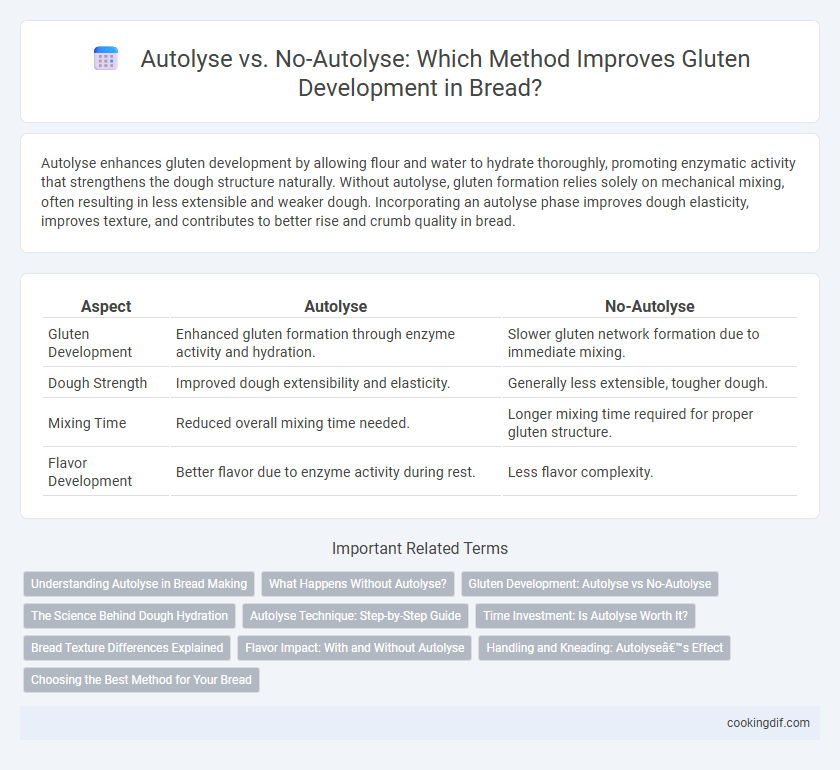Autolyse enhances gluten development by allowing flour and water to hydrate thoroughly, promoting enzymatic activity that strengthens the dough structure naturally. Without autolyse, gluten formation relies solely on mechanical mixing, often resulting in less extensible and weaker dough. Incorporating an autolyse phase improves dough elasticity, improves texture, and contributes to better rise and crumb quality in bread.
Table of Comparison
| Aspect | Autolyse | No-Autolyse |
|---|---|---|
| Gluten Development | Enhanced gluten formation through enzyme activity and hydration. | Slower gluten network formation due to immediate mixing. |
| Dough Strength | Improved dough extensibility and elasticity. | Generally less extensible, tougher dough. |
| Mixing Time | Reduced overall mixing time needed. | Longer mixing time required for proper gluten structure. |
| Flavor Development | Better flavor due to enzyme activity during rest. | Less flavor complexity. |
Understanding Autolyse in Bread Making
Autolyse in bread making enhances gluten development by hydrating flour before mixing with yeast and salt, resulting in improved dough extensibility and strength. This rest period promotes enzymatic activity that breaks down proteins and starches, facilitating better gluten network formation compared to no-autolyse methods. Bakers often observe that autolyse doughs require less kneading and yield bread with superior crumb structure and texture.
What Happens Without Autolyse?
Without autolyse, gluten development is slower and less efficient, resulting in a denser bread crumb with reduced volume. Dough mixing requires more mechanical effort to achieve adequate gluten structure, which can lead to over-oxidation and diminished flavor complexity. The absence of autolyse limits enzymatic activity, decreasing dough extensibility and overall fermentation quality.
Gluten Development: Autolyse vs No-Autolyse
Autolyse enhances gluten development by allowing flour and water to hydrate before kneading, leading to improved dough extensibility and strength. Without autolyse, gluten networks form less efficiently, often requiring more intensive kneading to achieve similar elasticity and structure. This process reduces oxidation and enzymatic degradation, resulting in better dough handling and superior bread crumb texture.
The Science Behind Dough Hydration
Autolyse enhances gluten development by allowing flour to fully hydrate and enzymatic activity to break down starches into simpler sugars, improving dough extensibility and structure. Without autolyse, gluten strands form less uniformly, leading to a denser crumb and reduced gas retention. Optimal dough hydration levels during autolyse facilitate protein alignment and strengthen the gluten network, crucial for loaf volume and texture.
Autolyse Technique: Step-by-Step Guide
The autolyse technique enhances gluten development by hydrating flour and initiating enzymatic activity before kneading, resulting in improved dough extensibility and structure. To perform autolyse, mix flour and water only, then rest the mixture for 20-60 minutes, allowing natural enzymes to break down proteins and starches. After the rest period, add salt and yeast, then proceed with kneading, which requires less effort due to the pre-developed gluten network.
Time Investment: Is Autolyse Worth It?
Autolyse significantly reduces overall mixing time by allowing flour hydration and enzyme activity to develop gluten naturally, which results in a stronger, more extensible dough. Without autolyse, longer mechanical mixing is required to achieve comparable gluten development, increasing time and energy use. Time investment in autolyse typically ranges from 20 to 60 minutes, yielding improved dough quality and reduced kneading time, making it a highly efficient technique for bakers seeking optimal gluten structure.
Bread Texture Differences Explained
Autolyse enhances gluten development by allowing flour and water to hydrate before mixing, resulting in a dough with improved elasticity and extensibility. Bread made with autolyse typically has a more open crumb structure, softer texture, and better volume compared to no-autolyse dough. In contrast, no-autolyse bread often exhibits denser crumb, tougher texture, and less oven spring due to insufficient gluten formation.
Flavor Impact: With and Without Autolyse
Autolyse enhances gluten development by allowing enzymes to break down starches and proteins, resulting in improved dough extensibility and flavor complexity during fermentation. Without autolyse, gluten development relies solely on mechanical kneading, often producing a less aromatic and less nuanced crumb profile. Studies show autolysed doughs yield bread with a richer, more developed taste due to increased enzymatic activity and Maillard reactions during baking.
Handling and Kneading: Autolyse’s Effect
Autolyse significantly improves dough handling by allowing flour to fully hydrate before kneading, resulting in a smoother and more extensible dough with better gluten development. This process reduces the need for extensive kneading, as enzymes naturally break down starches and proteins, enhancing dough elasticity and strength. Without autolyse, the dough often requires more mechanical kneading to achieve similar gluten formation and can feel tighter and less manageable.
Choosing the Best Method for Your Bread
Autolyse enhances gluten development by allowing flour and water to hydrate before kneading, resulting in improved dough elasticity and extensibility that supports better rise and crumb structure in artisan bread. No-autolyse methods require extended kneading to develop gluten, which can increase oxidation and reduce flavor complexity, but may be preferable for faster processing and certain dough types. Bakers seeking optimal gluten strength and flavor often choose autolyse for superior dough handling and bread quality, while no-autolyse suits recipes demanding quicker turnaround.
Autolyse vs No-Autolyse for gluten development Infographic

 cookingdif.com
cookingdif.com